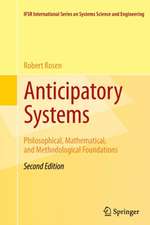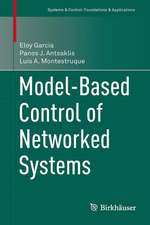Data Mining Methods for Knowledge Discovery: The Springer International Series in Engineering and Computer Science, cartea 458
Autor Krzysztof J. Cios, Witold Pedrycz, Roman W. Swiniarskien Limba Engleză Paperback – 26 oct 2012
Data Mining Methods for Knowledge Discovery is intended for senior undergraduate and graduate students, as well as a broad audience of professionals in computer and information sciences, medical informatics, and business information systems.
| Toate formatele și edițiile | Preț | Express |
|---|---|---|
| Paperback (1) | 998.04 lei 43-57 zile | |
| Springer Us – 26 oct 2012 | 998.04 lei 43-57 zile | |
| Hardback (1) | 1002.34 lei 43-57 zile | |
| Springer Us – 31 aug 1998 | 1002.34 lei 43-57 zile |
Din seria The Springer International Series in Engineering and Computer Science
- 24%
 Preț: 1041.98 lei
Preț: 1041.98 lei - 20%
 Preț: 643.50 lei
Preț: 643.50 lei - 18%
 Preț: 1225.62 lei
Preț: 1225.62 lei - 18%
 Preț: 965.02 lei
Preț: 965.02 lei - 20%
 Preț: 646.12 lei
Preț: 646.12 lei - 18%
 Preț: 948.79 lei
Preț: 948.79 lei - 20%
 Preț: 646.62 lei
Preț: 646.62 lei - 15%
 Preț: 637.46 lei
Preț: 637.46 lei - 20%
 Preț: 643.83 lei
Preț: 643.83 lei - 18%
 Preț: 949.23 lei
Preț: 949.23 lei - 20%
 Preț: 644.48 lei
Preț: 644.48 lei - 20%
 Preț: 994.92 lei
Preț: 994.92 lei - 20%
 Preț: 645.97 lei
Preț: 645.97 lei - 18%
 Preț: 946.87 lei
Preț: 946.87 lei - 20%
 Preț: 995.57 lei
Preț: 995.57 lei - 18%
 Preț: 956.99 lei
Preț: 956.99 lei - 20%
 Preț: 644.98 lei
Preț: 644.98 lei - 15%
 Preț: 649.54 lei
Preț: 649.54 lei - 18%
 Preț: 950.21 lei
Preț: 950.21 lei - 18%
 Preț: 1221.38 lei
Preț: 1221.38 lei - 18%
 Preț: 957.62 lei
Preț: 957.62 lei - 15%
 Preț: 643.99 lei
Preț: 643.99 lei - 18%
 Preț: 948.47 lei
Preț: 948.47 lei - 18%
 Preț: 947.35 lei
Preț: 947.35 lei - 20%
 Preț: 1284.65 lei
Preț: 1284.65 lei - 20%
 Preț: 1628.31 lei
Preț: 1628.31 lei - 20%
 Preț: 1285.78 lei
Preț: 1285.78 lei
Preț: 998.04 lei
Preț vechi: 1247.55 lei
-20% Nou
Puncte Express: 1497
Preț estimativ în valută:
191.04€ • 207.58$ • 160.57£
191.04€ • 207.58$ • 160.57£
Carte tipărită la comandă
Livrare economică 21 aprilie-05 mai
Preluare comenzi: 021 569.72.76
Specificații
ISBN-13: 9781461375579
ISBN-10: 1461375576
Pagini: 520
Ilustrații: XXI, 495 p.
Dimensiuni: 155 x 235 x 27 mm
Greutate: 0.72 kg
Ediția:Softcover reprint of the original 1st ed. 1998
Editura: Springer Us
Colecția Springer
Seria The Springer International Series in Engineering and Computer Science
Locul publicării:New York, NY, United States
ISBN-10: 1461375576
Pagini: 520
Ilustrații: XXI, 495 p.
Dimensiuni: 155 x 235 x 27 mm
Greutate: 0.72 kg
Ediția:Softcover reprint of the original 1st ed. 1998
Editura: Springer Us
Colecția Springer
Seria The Springer International Series in Engineering and Computer Science
Locul publicării:New York, NY, United States
Public țintă
ResearchCuprins
1 Data Mining and Knowledge Discovery.- 1.1 Data Mining and Information Age: Emerging Quests.- 1.2 Defining Knowledge Discovery.- 1.3 Architectures of Knowledge Discovery.- 1.4 Knowledge Representation.- 1.5 Main Types of Revealed Patterns.- 1.6 Basic Models of Data Mining.- 1.7 Knowledge Discovery and Related Research Areas.- 1.8 Main Features of a Knowledge Discovery Process.- 1.9 Coping with Reality. Sampling in Databases.- 1.10 Selected Examples of Knowledge Discovery Systems.- 1.11 Summary.- References.- Additional Readings.- 2 Rough Sets.- 2.1 Introduction.- 2.2 Information System.- 2.3 Indiscernibility Relation.- 2.4 Discernibility Matrix.- 2.5 Decision Tables.- 2.6 Approximation of Sets. Approximation Space.- 2.7 Accuracy of Approximation.- 2.8 Approximation and Accuracy of Classification.- 2.9 Classification and Reduction.- Reduct and Core.- 2.10 Decision Rules.- 2.11 Dynamic Reducts.- 2.12 Summary.- 2.13 Exercises.- References.- Appendix A2: Algorithms for Finding Minimal Subsets.- 3 Fuzzy Sets.- 3.1 Introduction.- 3.2 Basic Definition.- 3.3 Types of Membership Functions.- 3.4 Characteristics of a Fuzzy Set.- 3.5 Membership Function Determination.- 3.6 Fuzzy Relations.- 3.7 Set Theory Operations and Their Properties.- 3.8 The Extension Principle and Fuzzy Arithmetic.- 3.9 Information—Based Characteristics of Fuzzy Sets.- 3.10 Numerical Representation of Fuzzy Sets.- 3.11 Rough Sets and Fuzzy Sets.- 3.12 The Frame of Cognition.- 3.13 Probability and Fuzzy Sets.- 3.14 Summary.- 3.15 Exercises.- References.- 4 Bayesian Methods.- 4.1 Introduction.- 4.2 Basics of Bayesian Methods.- 4.3 Involving Object Features in Classification.- 4.4 Bayesian Classification — a General Case.- 4.5 Statistical Classification Minimizing Risk.- 4.6 Decision Regions. Probabilitiesof Errors.- 4.7 Discriminant Functions.- 4.8 Estimation of Probability Densities.- 4.9 Probabilistic Neural Network (PNN).- 4.10 Constraints in Design.- 4.11 Summary.- 4.12 Exercises.- References.- 5 Evolutionary Computing.- 5.1 Genetic Algorithms. Concept and Algorithmic Aspects.- 5.2 Fundamental Components of GAs 196 Encoding and Decoding.- 5.3 GA. Formal Definition of Genetic Algorithms.- 5.4 Schemata Theorem: a Cnceptual Backbone of Gas.- 5.5 Genetic Computing. Further Enhancement.- 5.6 Exploration and Exploitation of the Search Space.- 5.7 Experimental Studies.- 5.8 Classes of Evolutionary Computation.- 5.9 Genetic Optimization of Rule-Based Description of Data: Pittsburgh and Michigan Approaches.- 5.10 Summary.- 5.11 Exercises.- References.- 6 Machine Learning.- 6.1 Introduction.- 6.2 Introduction to Generation of Hypotheses.- 6.3 Overfitting.- 6.4 Rule Algorithms.- 6.5 Decison Tree Algorithms.- 6.6 Hybrid Algorithms.- 6.7 Discretization of Continuous-Valued Attributes.- 6.7.1 Information-Theoretic Discretization Methods.- 6.8 Hypothesis Evaluation.- 6.9 Comparison of the Three Families of Algorithms.- 6.10 Machine Learning in Knowledge Discovery.- 6.11 Machine Learning and Rough Sets.- 6.12 Summary.- 6.13 Exercises.- References.- Appendix A6: Diagnosing Coronary Artery Disease (CAD).- References.- 7 Neural Networks.- 7.1 Introduction.- 7.2 Radial Basis Function (RBF) Network.- 7.3 RBF Networks in Knowledge Discovery.- 7.4 Kohonen’s Self Organizing Map(SOM)Network.- 7.5 Image Recognition Neural Network (IRNN) 357 Sensory Layer.- 7.6 Summary.- 7.7 Exercises.- References.- Appendix A7: Image Similarity(IS) Measure.- 8 Clustering.- 8.1 Unsupervised Learning: a General Taxonomy and Related Algorithmic Aspects.- 8.2 Hierarchical Clustering.- 8.3 ObjectiveFunction—Based Clustering.- 8.4 Clustering Methods and Data Mining.- 8.5 Hierarchical Clustering in Building Associations in the Data.- 8.6 Clustering under Partial Supervision in Data Mining.- 8.7 A Neural Realization of Similarity Between Patterns.- 8.8 Numerical Experiments.- 8.9 Summary.- 8.10 Exercises.- References.- 9 Preprocessing.- 9.1 Patterns and Features.- 9.2 Preprocessing Operations.- 9.3 Principal Component Analysis — Feature Extraction and Reduction.- 9.4 Supervised Feature Reduction Based on Fisher’s Linear Discriminant Analysis.- 9.5 Sequence of Karhunen-Loeve and Fisher’s Linear Discriminant Projections.- 9.6 Feature Selection.- 9.7 Numerical Experiments — Texture Image Classification.- 9.8 Summary.- 9.9 Exercises.- References.














